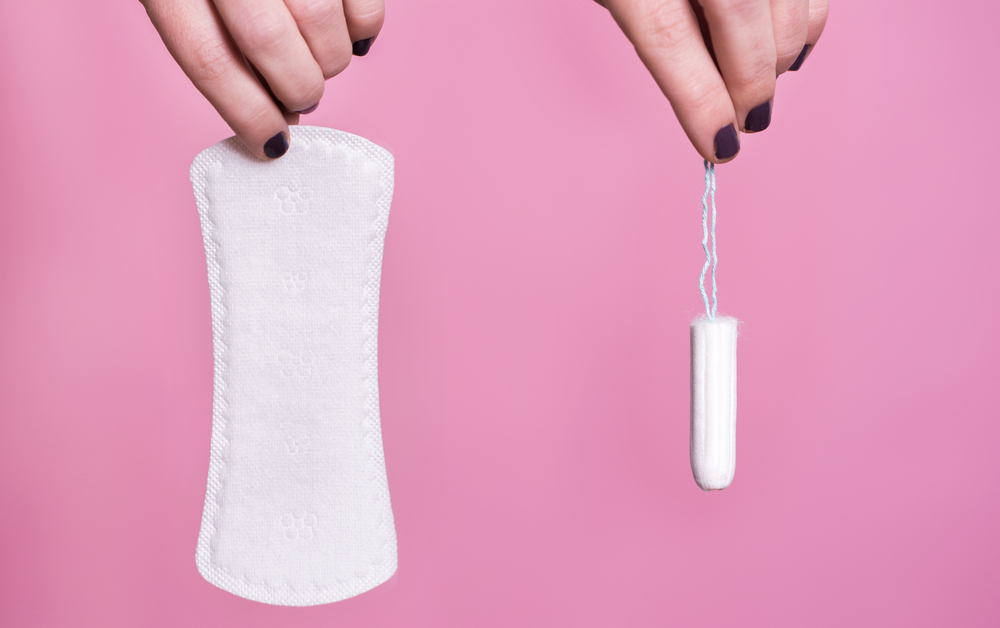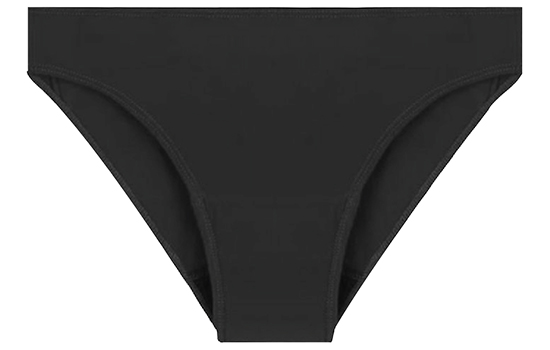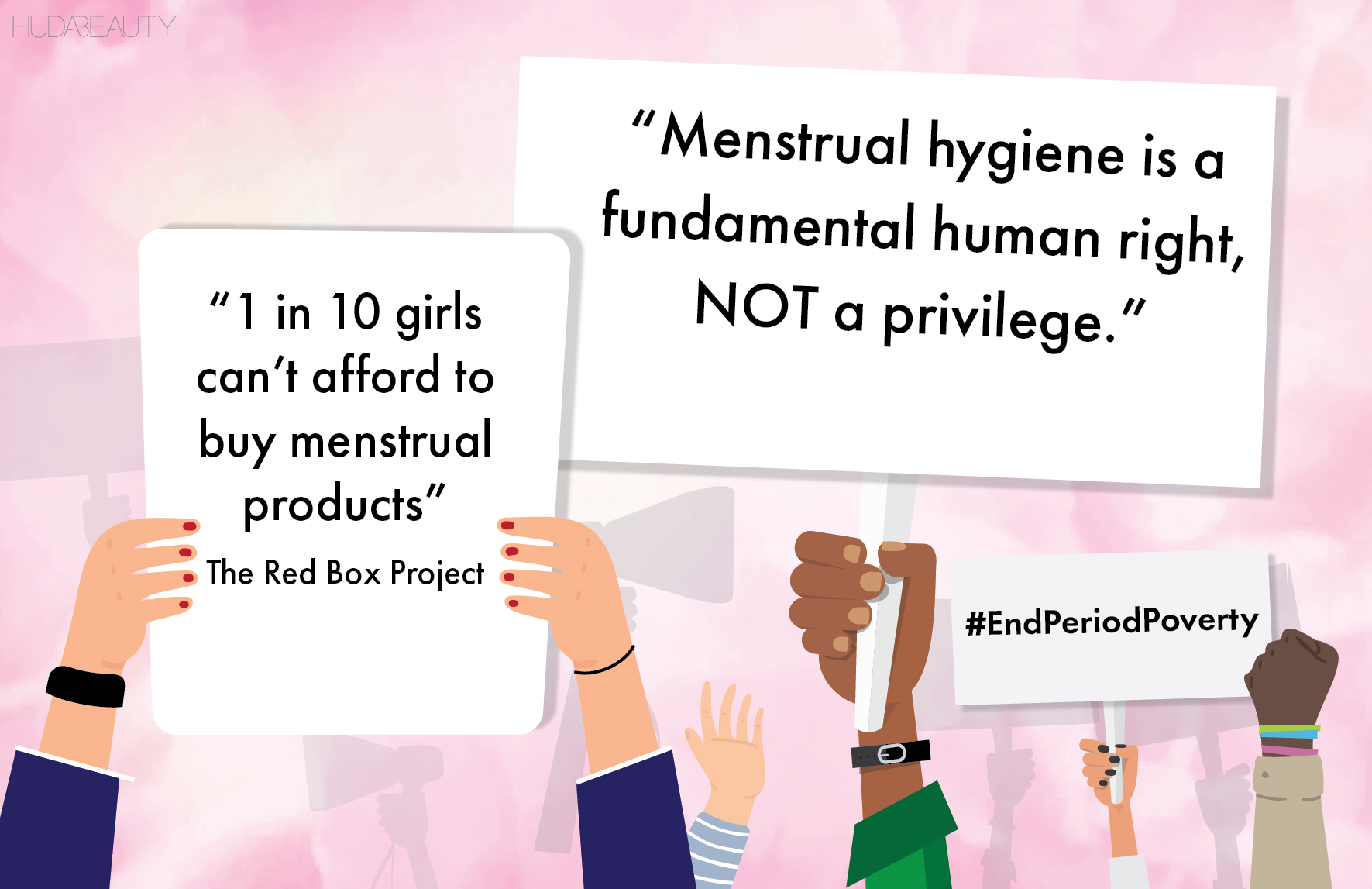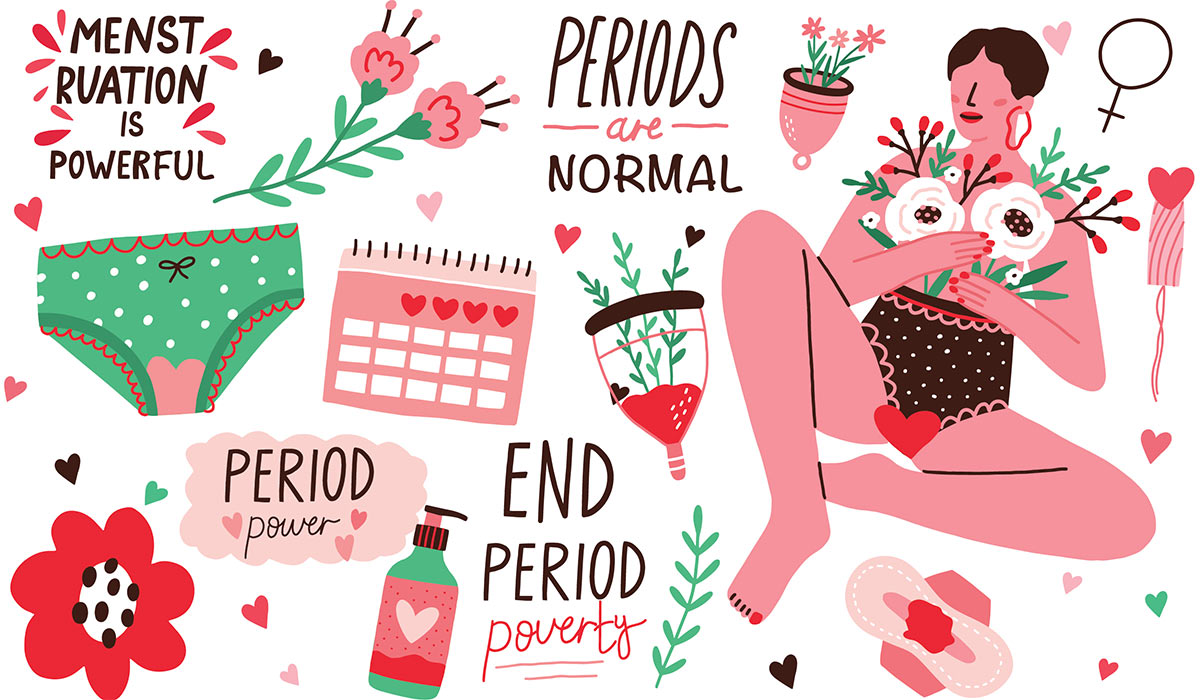Tampons, Pads & What You Need To Know About Your Period!
 Source: RomarioIen/Shutterstock
Source: RomarioIen/Shutterstock
Almost half the world’s population will experience needing menstrual products during their lifetime and yet it still remains a “taboo topic” that many aren’t taught about. In fact, many of us feel we should avoid talking about our period or hide our sanitary products from our friends, parents, or co-workers. Here at Huda Beauty, we feel it’s time for that to stop. We want to normalize periods!
The thing is, the more we spoke about this topic (check out these period stories) the more we became aware of just how many young menstruators were having periods with absolutely no prior understanding of what they were. So we want to provide a safe place for you to learn what a period is and what you’re meant to use during this time – knowledge is power. So, we’re giving you the lowdown on tampons, pads, and menstrual cups, toxic shock syndrome, and more. Here’s everything you need to know…
What Are Periods?
First and foremost, if you’re unaware of what a period is, it occurs when the lining of a women’s uterus (AKA your reproductive organ) breaks down and exits the body – resulting in vaginal bleeding. Most menstruators bleed for anywhere between five to seven days, although for some, it might be as short as just one or two days. It typically occurs every 28 days however, for many, it’s not regular and similarly can last for a shorter or longer period of time (no pun intended). People tend to get their period anywhere between the ages of 9 to 16.
During this time, if you are fortunate enough to have access to sanitary products, most commonly, you might use a tampon or a pad to absorb the blood exiting the body. When it comes to choosing what product to use, Dr. Mary Jane Minkin, Professor in the Department of Obstetrics, Gynecology, and Reproductive Sciences at the Yale University School of Medicine says it’s simply a personal choice. Many menstruators prefer to use tampons while others opt for pads or alternatives such as menstrual cups or discs. Dr. Doris Day, New York’s leading dermatologist (and author of Beyond Beautiful), tells us that it’s all about finding a product that meets your period needs and matches your flow, as some people may have heavier periods than others.
The Dos and Don’ts of Wearing Pads:
 Source: Ema Woo/Shutterstock
Source: Ema Woo/Shutterstock
Pads are worn outside of your body and are an absorbent liner that you attach to your underwear (the sticky side should be facing down, as this helps the pad to adhere to your underwear). Dr. Day shares her useful tips on how to avoid skin irritation, leaks, or infection.
Do choose a pad that matches your flow: “You may be tempted to leave a heavy pad on all day if you have a lighter flow, but this can lead to irritation of the skin from both the fabric of the pad and from the friction of the pad against the skin.”
Don’t choose fragranced pads: “Fragrances can be a source of allergy and skin irritation. A regular flow does not have an odor different from the smell of your body in general, and it is much better to change the pad than to try to conceal the odor of one left in too long.”
Do change it often: “Even if your flow is light and your pad doesn’t seem to need changing, you should still change it every four hours. This is because bacteria can grow in the blood once outside your body, which can cause an odor.”
Dos and Don’ts of Using Tampons:
 Source: Flo
Source: Flo
Tampons are another popular form of menstrual product and are inserted into the vagina to absorb blood flow. There are a variety of different forms of tampons, from non-applicator to applicator tampons; tampons that have an applicator are concealed in a plastic or cardboard package that allows for easy insertion. Just be mindful that many applicator tampons are made from plastic, which cannot be recycled, so you can opt for cardboard applicators, non-applicator tampons or reusable tampon applicators instead.
Do pay attention to the material: “Choose tampons that are made from cotton or rayon fibers rather than polyester foam,” advises Dr. Day. You’ll find that many tampons and pads are now made from organic materials that are free of any nasty chemicals so always keep an eye out when purchasing tampons or pads. We’re obsessed with the menstrual care brand Flo, which makes sanitary products including tampons, pads, and liners out of natural, plant-based, biodegradable, and hypoallergenic materials like organic cotton and bamboo.
Posts You'll Love:
Don’t be rough: Dr. Day warns, “Be gentle when putting them in and taking them out to avoid creating breaks in the skin along the way.” Tampons with an applicator will make insertion easier and more comfortable (especially if you’re a first-time user).
Do change it often: You should change your tampon every four to eight hours, or even more often if you’re heavy.
Do give yourself a break: Dr. Minkin advises to “Not use tampons 100% of the time during your period.” Instead, she recommends that you “Give your vagina a break. For example, don’t wear them overnight, if you like to use them during the day or vice versa.”
Do use a tampon to match your flow: Dr. Day explains, “To avoid leaking, you should use a superabsorbent tampon when your flow is heavier and change it often. Similarly, you should avoid using a superabsorbent tampon on a lighter day since there is less blood flow and the tampon can dry out the vagina. This can irritate and cause tiny breaks in the skin as you pull it out and put a new one in.”
Don’t use tampons if you’re prone to vaginal dryness: Dr. Minkin explains that “Continuous tampon use can dry the vagina, so for example, if you’re a perimenopausal woman prone to vaginal dryness, you may not want to use a tampon 100% of the time because of dryness issues.”
Alternative Sanitary Products
While most of you will be familiar with tampons and pads, there are now different alternatives that are often more economic and better for the environment. Here are some amazing sanitary solutions:
Menstrual Cups
 Source: Diva
Source: Diva
Menstrual cups are a relatively new sanitary solution; the cup-shaped devices have a stem to help insert and remove them. They are usually made of flexible silicone and create a seal against the vaginal wall just below the cervix. They collect the fluid rather than absorbing it. For some, it’s a good option because it can be washed and reused for three to five years, making it very economical and eco-friendly. They normally offer a variety of sizes depending on your age and whether you’ve had children. However, if they’re left in for too long, it can pose a risk for infection, especially if it scrapes too hard against the vaginal wall on the way in or out, creating breaks in the skin, which act as a portal of entry for the bacteria and the poison it creates.
Menstrual cups can be a little more difficult to use and get used to, but they’re also a much more cost-effective solution in the long-run. We’re obsessed with our TheDivaCup Menstrual Cup, $38, as it feels really comfortable when inserted and helps avoid leaks. Plus, you never have to worry about running out of tampons or pads when you’re on-the-go. We also love the Lily Cup, $29, from Intimina, as the flexible material allows for easy insertion.
Most recently, brands have also started to release menstrual discs like the Flex Start Kit, $13, which are one-time-use period products that sit above the vaginal canal (like a tampon or cup) and allows you to enjoy a mess-free (ish) period, without worrying about leaks or discomfort. It can also be worn during intercourse.
Period Underwear
 Source: Thinx
Source: Thinx
If you’re looking for an eco-friendly and more economical alternative to tampons or pads, then consider investing in a pair of period underwear. They’re just like regular underwear however, they’re made from figure-hugging, super-absorbent fabric. While the idea of free bleeding may sound unusual, many said they cannot even feel that they’re bleeding. Most brands also have a range of underwear styles as well as absorbency levels so you can find a pair you find comfortable and meet your period needs. We’ve heard rave reviews about the Thinx Hip Hugger, $36, as well as the Ruby Period Underwear Bikini, $19, which is made from 82% knit blend and 18% spandex so it’s super comfortable and feels really supportive.
Toxic Shock Syndrome:
What Toxic Shock is: Dr. Day explains, “A tampon, when saturated with blood, becomes a great environment for growing bacteria, especially Staphylococcus aureus. This is a bacteria commonly found and harmlessly present in the vagina. For reasons that are still unclear, under certain conditions the bacteria can rapidly grow and release poisons which, if they get into the bloodstream can cause toxic shock syndrome (TSS), which can be fatal. It seems to be related to the superabsorbent tampons, especially ones made of polyester foam, and especially when they were left in for many hours, i.e., more 30 hours at a time.” We should warn that Toxic Shock Syndrome is not common, but it is something to be aware of so that you do not leave your tampons in for a dangerous amount of time.
While most menstrustors have heard a horror story about toxic shock syndrome, and naturally worry about it, Dr. Minkin also says it’s actually very rare! “Even at the height of the toxic shock “epidemic” (1980-81) there were about 200+ cases annually in the US so it was very rare. I think in the last report from the CDC who collects this data there were less than 30 cases a year in the whole US. And there have been occasional cases reported with menstrual cups so using a cup as opposed to a tampon does not completely eliminate the risk.”
How Toxic Shock happens: “Having an overgrowth of bacteria alone will not cause toxic shock syndrome, the poison also needs to get into the bloodstream. This can be due to breaks in the skin, which can occur from various causes including the simple act of pushing a tampon into place, especially if the area is dry.”
The symptoms of Toxic Shock Syndrome include “Headaches, fatigue, a red rash on most of your body that can look like a sunburn, vomiting, low blood pressure, or low urine production. This can occur within two days of infection. Fortunately, it is rare, but it can be fatal if not treated and those who get it are more prone to getting it again and should avoid using tampons, sponges or diaphragms” says Dr. Day.
What else can affect your period?
 Source: areeya_ann/Shutterstock
Source: areeya_ann/Shutterstock
Hormonal contraceptives can also limit or regulate how often you get your period, and many are prescribed to make periods lighter and help with menstrual cramps. These are considered safe and effective, and your doctor can help select the best option for you.
There are lots of other factors that can affect how heavy or uncomfortable your periods are, like endometriosis or polycystic ovaries. Find out more about what endometriosis is here and how polycystic ovaries could be affecting you and your body here.
Now you know exactly what you should be using on your period, here’s how to have a chill af period and keep any cramps under control.
The Bigger Issue!

There are millions of young menstruators around the world who don’t have access to menstrual sanitary care. In fact, due to the current pandemic, period poverty (when someone lacks access to sanitary products, menstrual hygiene education, toilets, handwashing facilities, and, or, waste management), is on the rise. Right now, it’s estimated that 1 in 5 American girls have missed school due to a lack of period protection while 1 in 10 girls in the UK can’t afford to buy menstrual products.
Not only are there people who aren’t able to find the necessary sanitary solutions during this time, but many have no idea what their period is, or are made to feel ashamed about it. There are some amazing charities around the globe that work to provide sanitary care to those who can’t afford or don’t have access to pads, while others also teach about menstruation and work on de-stigmatization in communities where the subject is taboo. If you would like to contribute, either with a donation or fund-raising event, please check out these charities:
Binti: Binti currently works in India, Africa, the UK, and the US, sharing three core aspects of their menstrual dignity mission: Access (providing sanitary products), education about menstruation, and what to expect, and de-stigmatization. Find out more at Binti.co.uk here.
Days for Girls: Days for Girls provides washable menstrual hygiene solutions, health education, and social enterprises to help them reach the last mile in their own communities. They work in over 110 countries around the globe. Find out more about DaysForGirls.org here.
#HappyPeriod: #HappyPeriod provides menstrual products to anyone with a period that has low-income, is homeless, or living in poverty, across the US. Find out more at hashtaghappyperiod.org here.
To learn more about this important cause, check out our post on period poverty and how you can get involved.
Disclaimer: Every product we review has been independently selected and tested without bias by our editorial team. We never take payment to review products, however, some brands allow affiliate links, so we may earn a commission if you purchase a product by clicking on one of our links.























Leave a comment